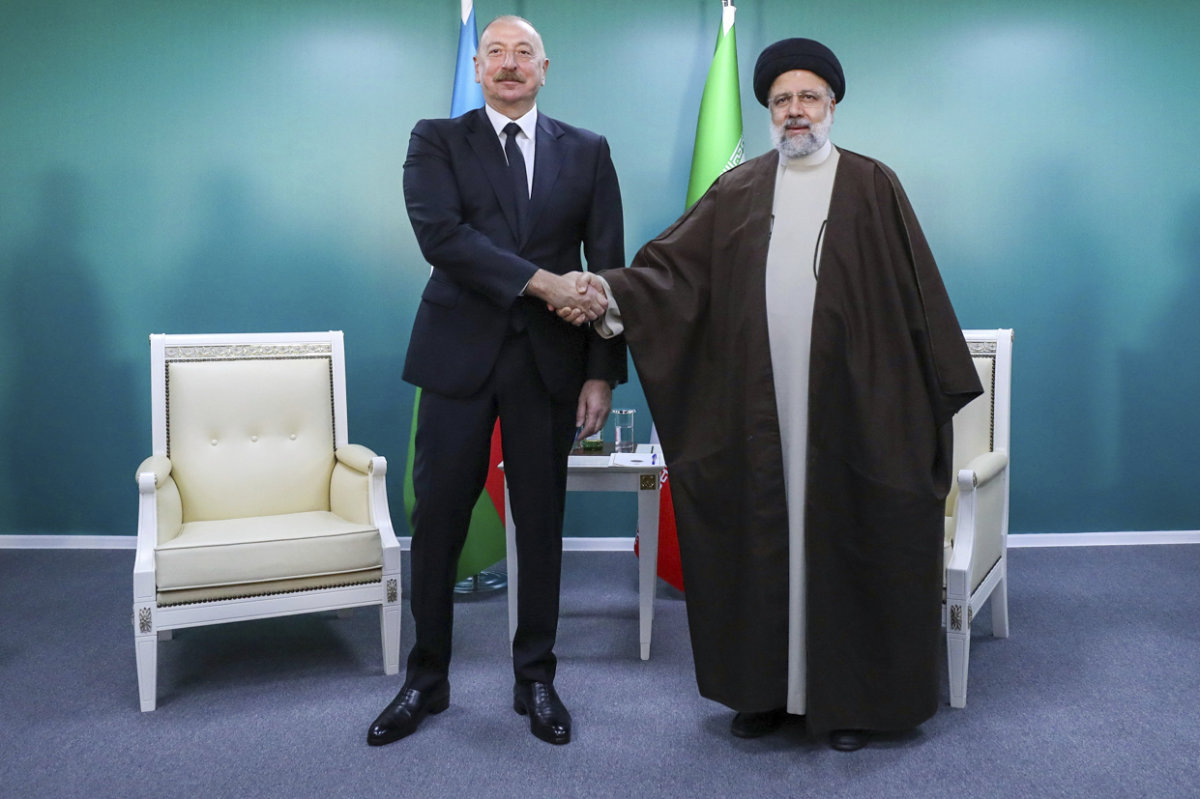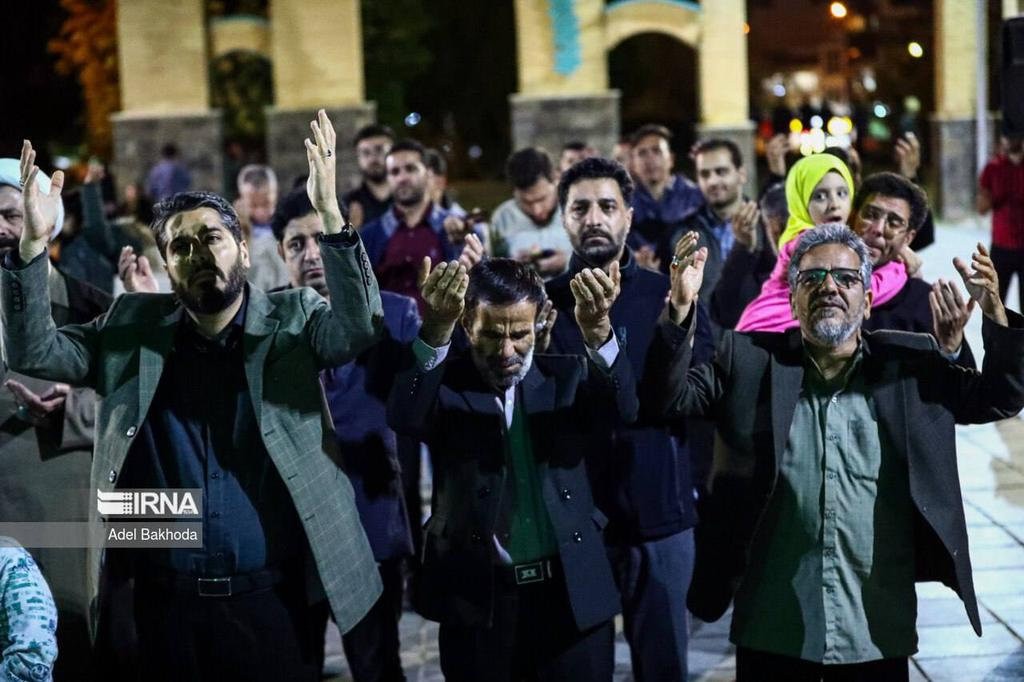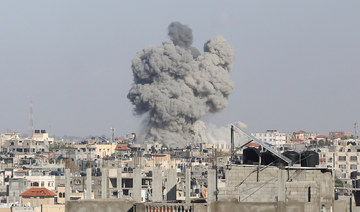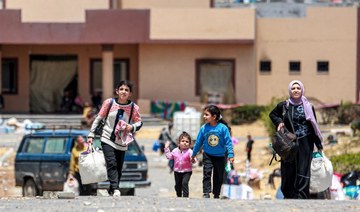JERUSALEM: Hamas announced its acceptance Monday of an Egyptian-Qatari ceasefire proposal, but Israel said the deal did not meet its “core demands” and that it was pushing ahead with an assault on the southern Gaza town of Rafah. Still, Israel said it would continue negotiations.
The high-stakes diplomatic moves and military brinkmanship left a glimmer of hope alive — but only barely — for an accord that could bring at least a pause in the 7-month-old war that has devastated the Gaza Strip. Hanging over the wrangling was the threat of an all-out Israeli assault on Rafah, a move the United States strongly opposes and that aid groups warn will be disastrous for some 1.4 million Palestinians taking refuge there.
Hamas’s abrupt acceptance of the ceasefire deal came hours after Israel ordered an evacuation of some 100,000 Palestinians from eastern neighborhoods of Rafah, signaling an invasion was imminent.
Israel’s War Cabinet decided to continue the Rafah operation, Prime Minister Benjamin Netanyahu’s office said. At the same time, it said that while the proposal Hamas agreed to “is far from meeting Israel’s core demands,” it would send negotiators to Egypt to work on a deal.
The Israeli military said it was conducting “targeted strikes” against Hamas in eastern Rafah. The nature of the strikes was not immediately known, but the move appeared aimed at keeping the pressure on as talks continue.
President Joe Biden spoke with Prime Minister Benjamin Netanyahu and reiterated US concerns about an invasion of Rafah. US State Department spokesman Matthew Miller said American officials were reviewing the Hamas response “and discussing it with our partners in the region.” An American official said the US was examining whether what Hamas agreed to was the version signed off to by Israel and international negotiators or something else.
It was not immediately known if the proposal Hamas agreed to was substantially different from one that US Secretary of State Antony Blinken pressed the militant group to accept last week, which Blinken said included significant Israeli concessions.
Egyptian officials said that proposal called for a ceasefire of multiple stages starting with a limited hostage release and partial Israeli troop pullbacks within Gaza. The two sides would also negotiate a “permanent calm” that would lead to a full hostage release and greater Israeli withdrawal out of the territory, they said.
Hamas sought clearer guarantees for its key demand of an end to the war and complete Israeli withdrawal in return for the release of all hostages, but it wasn’t clear if any changes were made.
Israeli leaders have repeatedly rejected that trade-off, vowing to keep up their campaign until Hamas is destroyed after its Oct. 7 attack on Israel that triggered the war.
Netanyahu is under pressure from hard-line partners in his coalition who demand an attack on Rafah and could collapse his government if he signs onto a deal. But he also faces pressure from the families of hostages to reach a deal for their release.
Thousands of Israelis rallied around the country Monday night calling for an immediate agreement. About a thousand protesters swelled near the defense headquarters in Tel Aviv, where police tried to clear the road. In Jerusalem, about a hundred protesters marched toward Netanyahu’s residence with a banner reading, “The blood is on your hands.”
Israel says Rafah is the last significant Hamas stronghold in Gaza, and Netanyahu said Monday that the offensive against the town was vital to ensuring the militants can’t rebuild their military capabilities.
But he faces strong American opposition. Miller said Monday the US has not seen a credible and implementable plan to protect Palestinian civilians. “We cannot support an operation in Rafah as it is currently envisioned,” he said.
The looming operation has raised global alarm. Aid agencies have warned that an offensive will bring a surge of more civilian deaths in an Israeli campaign that has already killed 34,000 people and devastated the territory. It could also wreck the humanitarian aid operation based out of Rafah that is keeping Palestinians across the Gaza Strip alive, they say.
UN High Commissioner for Human Rights Volker Türk on Monday called the evacuation order “inhumane.”
“Gazans continue to be hit with bombs, disease, and even famine. And today, they have been told that they must relocate yet again,” he said. “It will only expose them to more danger and misery.”
Israeli leaflets, text messages and radio broadcasts ordered Palestinians to evacuate eastern neighborhoods of Rafah, warning that an attack was imminent and anyone who stays “puts themselves and their family members in danger.”
The military told people to move to an Israel-declared humanitarian zone called Muwasi, a makeshift camp on the coast. It said Israel has expanded the size of the zone and that it included tents, food, water and field hospitals.
It wasn’t immediately clear, however, if that was already in place.
Around 450,000 displaced Palestinians already are sheltering in Muwasi. The UN agency for Palestinian refugees, known as UNRWA, said it has been providing them with aid. But conditions are squalid, with few sanitation facilities in the largely rural area, forcing families to dig private latrines.
Jan Egeland, secretary-general of the Norwegian Refugee Council, condemned the “forced, unlawful” evacuation order to Muwasi.
“The area is already overstretched and devoid of vital services,” Egeland said.
The evacuation order left Palestinians in Rafah wrestling with having to uproot their families once again for an unknown fate, exhausted after months living in sprawling tent camps or crammed into schools or other shelters in and around the city. Israeli airstrikes on Rafah early Monday killed 22 people, including children and two infants.
Mohammed Jindiyah said that at the beginning of the war, he tried to hold out in his home in northern Gaza under heavy bombardment before fleeing to Rafah.
He is complying with Israel’s evacuation order this time, but was unsure whether to move to Muwasi or elsewhere.
“We are 12 families, and we don’t know where to go. There is no safe area in Gaza,” he said.
Sahar Abu Nahel, who fled to Rafah with 20 family members, including her children and grandchildren, wiped tears from her cheeks, despairing at a new move.
“I have no money or anything. I am seriously tired, as are the children,” she said. “Maybe it’s more honorable for us to die. We are being humiliated.”
Israel’s bombardment and ground offensives in Gaza have killed more than 34,700 Palestinians, around two-thirds of them children and women, according to Gaza health officials. The tally doesn’t distinguish between civilians and combatants. More than 80 percent of the population of 2.3 million have been driven from their homes, and hundreds of thousands in the north are on the brink of famine, according to the UN
The war was sparked by the unprecedented Oct. 7 raid into southern Israel in which Palestinian militants killed around 1,200 people, mostly civilians, and abducted some 250 hostages. After exchanges during a November ceasefire, Hamas is believed to still hold about 100 Israelis as well the bodies of around 30 others.
Hamas accepts Gaza ceasefire; Israel says it will continue talks but launches strikes in Rafah
https://arab.news/z9e2k
Hamas accepts Gaza ceasefire; Israel says it will continue talks but launches strikes in Rafah

- Uncertain whether a deal had been sealed to bring a halt to the seven-month war in Gaza
- Palestinians in Rafah celebrated after announcement, hoping it meant the invasion would be averted
India’s Modi says ‘deeply saddened and shocked’ by Raisi’s death

- ‘My heartfelt condolences to his family and the people of Iran’
“My heartfelt condolences to his family and the people of Iran,” Modi posted on X, formerly Twitter. “India stands with Iran in this time of sorrow.”
Iran’s president, foreign minister and others found dead at helicopter crash site, state media says

- “We can see the wreckage and the situation does not look good,” Red Crescent official said
- Turkish drone footage suggesting the helicopter went down in the mountains
DUBAI: Iranian President Ebrahim Raisi, the country’s foreign minister and others have been found dead at the site of a helicopter crash Monday after an hourslong search through a foggy, mountainous region of the country’s northwest, state media reported. Raisi was 63.
The crash comes as the Middle East remains unsettled by the Israel-Hamas war, during which Raisi under Supreme Leader Ayatollah Ali Khamenei launched an unprecedented drone-and-missile attack on Israel just last month. Under Raisi, Iran enriched uranium closer than ever to weapons-grade levels, further escalating tensions with the West as Tehran also supplied bomb-carrying drones to Russia for its war in Ukraine and armed militia groups across the region.
Meanwhile, Iran has faced years of mass protests against its Shiite theocracy over its ailing economy and women’s rights – making the moment that much more sensitive for Tehran and the future of the country.
State TV gave no immediate cause for the crash in Iran’s East Azerbaijan province. Among the dead was Iranian Foreign Minister Hossein Amirabdollahian, 60.

Raisi was traveling in Iran’s East Azerbaijan province. State TV said what it called a “hard landing” happened near Jolfa, a city on the border with the nation of Azerbaijan, some 600 kilometers (375 miles) northwest of the Iranian capital, Tehran. Later, state TV put it farther east near the village of Uzi, but details remained contradictory.
With Raisi were Iran’s Foreign Minister Hossein Amirabdollahian, the governor of Iran’s East Azerbaijan province and other officials and bodyguards, the state-run IRNA news agency reported. One local government official used the word “crash,” but others referred to either a “hard landing” or an “incident.”
Early Monday morning, Turkish authorities released what they described as drone footage showing what appeared to be a fire in the wilderness that they “suspected to be wreckage of helicopter.” The coordinates listed in the footage put the fire some 20 kilometers (12 miles) south of the Azerbaijan-Iranian border on the side of a steep mountain.

Footage released by the IRNA early Monday showed what the agency described as the crash site, across a steep valley in a green mountain range. Soldiers speaking in the local Azeri language said: “There it is, we found it.”
Shortly after, state TV in an on-screen scrolling text said: “There is no sign of live from people on board.” It did not elaborate, but the semiofficial Tasnim news agency showed rescuers using a small drone to fly over the site, with them speaking among themselves saying the same thing.
Religious leaders had urged the public to pray. State TV aired images of hundreds of the faithful, some with their hands outstretched in supplication, praying at Imam Reza Shrine in the city of Mashhad, one of Shiite Islam’s holiest sites, as well as in Qom and other locations across the country. State television’s main channel aired the prayers nonstop.
In Tehran, a group of men kneeling on the side of the street clasped strands of prayer beads and watched a video of Raisi praying, some of them visibly weeping.
“If anything happens to him we’ll be heartbroken,” said one of the men, Mehdi Seyedi. ”May the prayers work and may he return to the arms of the nation safe and sound.”

IRNA called the area a “forest” and the region is known to be mountainous as well. State TV aired images of SUVs racing through a wooded area and said they were being hampered by poor weather conditions, including heavy rain and wind. Rescuers could be seen walking in the fog and mist.
Khamenei himself also urged the public to pray.
“We hope that God the Almighty returns the dear president and his colleagues in full health to the arms of the nation,” Khamenei said, drawing an “amen” from the worshipers he was addressing.
However, the supreme leader also stressed the business of Iran’s government would continue no matter what. Under the Iranian constitution, Iran’s vice first president takes over if the president dies with Khamenei’s assent, and a new presidential election would be called within 50 days. First Vice President Mohammad Mokhber already had begun receiving calls from officials and foreign governments in Raisi’s absence, state media reported.
Raisi, 63, a hard-liner who formerly led the country’s judiciary, is viewed as a protégé of Khamenei and some analysts have suggested he could replace the 85-year-old leader after Khamenei’s death or resignation.

Raisi had been on the border with Azerbaijan early Sunday to inaugurate a dam with Azerbaijan’s President Ilham Aliyev. The dam is the third one that the two nations built on the Aras River. The visit came despite chilly relations between the two nations, including over a gun attack on Azerbaijan’s Embassy in Tehran in 2023, and Azerbaijan’s diplomatic relations with Israel, which Iran’s Shiite theocracy views as its main enemy in the region.
Iran flies a variety of helicopters in the country, but international sanctions make it difficult to obtain parts for them. Its military air fleet also largely dates back to before the 1979 Islamic Revolution. IRNA published images it described as Raisi taking off in what resembled a Bell helicopter, with a blue-and-white paint scheme previously seen in published photographs.

Raisi won Iran’s 2021 presidential election, a vote that saw the lowest turnout in the Islamic Republic’s history. Raisi is sanctioned by the US in part over his involvement in the mass execution of thousands of political prisoners in 1988 at the end of the bloody Iran-Iraq war.
Under Raisi, Iran now enriches uranium at nearly weapons-grade levels and hampers international inspections. Iran has armed Russia in its war on Ukraine, as well as launched a massive drone-and-missile attack on Israel amid its war against Hamas in the Gaza Strip. It also has continued arming proxy groups in the Mideast, like Yemen’s Houthi rebels and Lebanon’s Hezbollah.
Meanwhile, mass protests in the country have raged for years. The most recent involved the 2022 death of Mahsa Amini, a woman who had been earlier detained over allegedly not wearing a hijab, or headscarf, to the liking of authorities. The monthslong security crackdown that followed the demonstrations killed more than 500 people and saw over 22,000 detained.
In March, a United Nations investigative panel found that Iran was responsible for the “physical violence” that led to Amini’s death.
Moroccans in pro-Palestinian march rally against Israel ties

- Rabat has officially denounced what it said were “flagrant violations of the provisions of international law” by Israel in its war against Hamas, but has not given any indication that normalization with Israel would be undone
- Israel has killed at least 35,456 people in Gaza, also mostly civilians, according to data provided by the Hamas-run territory’s health ministry
CASABLANCA, Morocco: Thousands of Moroccans demonstrated Sunday in Casablanca in support of the Palestinian people and against ties with Israel, an AFP journalist said, more than seven months into the Gaza war.
Protesters in Morocco’s commercial capital chanted “Freedom for Palestine,” “If we don’t speak out, who will?” and “No to normalization,” and many wore keffiyeh scarves or waved Palestinian flags.
The North African kingdom established diplomatic ties with Israel in late 2020 under the US-brokered Abraham Accords which saw similar moves by the United Arab Emirates and Bahrain.
Under the deal, the United States recognized Morocco’s claim to sovereignty over the disputed territory of Western Sahara.
Since the Israel-Hamas war in the Gaza Strip began on October 7, large-scale demonstrations in Morocco have called for the abrogation of the normalization accord.
On Sunday, the demonstrators marched through central Casablanca in a protest called by a grouping of leftist parties and Islamist movements.
“I cannot remain indifferent and silent in the face of what is happening to the Palestinians who are being killed on a daily basis,” demonstrator Zahra Bensoukar, 43, told AFP.
Idriss Amer, 48, said he was protesting “in solidarity with the Palestinian people, against the Zionist massacre in Gaza and against normalization” of ties with Israel.
Rabat has officially denounced what it said were “flagrant violations of the provisions of international law” by Israel in its war against Hamas, but has not given any indication that normalization with Israel would be undone.
The Gaza war broke out after Hamas on October 7 launched an unprecedented attack on Israel which resulted in the deaths of more than 1,170 people, mostly civilians, according to an AFP tally based on Israeli official figures.
Israel’s retaliatory offensive has killed at least 35,456 people in Gaza, also mostly civilians, according to data provided by the Hamas-run territory’s health ministry.
Hamas also took about 250 hostages on October 7, of whom 124 remain held in Gaza including 37 the Israeli military says are dead.
What do we know so far about the mysterious crash of the helicopter carrying Iran’s president?

- Initially, Interior Minister Ahmad Vahidi said the helicopter “was forced to make a hard landing due to the bad weather and fog”
BEIRUT: The apparent crash of a helicopter carrying Iran’s president and foreign minister on Sunday sent shock waves around the region.
Details remained scant in the hours after the incident, and it was unclear if Iranian President Ebrahim Raisi and the other officials had survived.
Here’s what we know so far.
WHO WAS ON BOARD THE HELICOPTER AND WHERE WERE THEY GOING?
The helicopter was carrying Iranian President Ebrahim Raisi, the country’s Foreign Minister Hossein Amirabdollahian, the governor of Iran’s East Azerbaijan province and other officials and bodyguards, according to the state-run IRNA news agency. Raisi was returning from a trip to Iran’s border with Azerbaijan earlier Sunday to inaugurate a dam with Azerbaijan’s President Ilham Aliyev, the news agency said.
WHERE AND HOW DID THE HELICOPTER GO DOWN?
The helicopter apparently crashed or made an emergency landing in the Dizmar forest between the cities of Varzaqan and Jolfa in Iran’s East Azerbaijan province, near its border with Azerbaijan, under circumstances that remain unclear. Initially, Interior Minister Ahmad Vahidi said the helicopter “was forced to make a hard landing due to the bad weather and fog.”
WHAT IS THE STATUS OF THE SEARCH OPERATIONS?
Iranian officials have said the mountainous, forested terrain and heavy fog impeded search-and-rescue operations. The president of the Iranian Red Crescent Society, Pir-Hossein Koulivand, said 40 search teams were on the ground in the area despite “challenging weather conditions.” The search is being done by teams on the ground, as “the weather conditions have made it impossible to conduct aerial searches” via drones, Koulivand said, according to IRNA.
IF RAISI DIED IN THE CRASH, HOW MIGHT THIS IMPACT IRAN?
Raisi is seen as a protégé to Iran’s supreme leader Ayatollah Ali Khamenei and a potential successor for his position within the country’s Shiite theocracy. Under the Iranian constitution, if he died, the country’s first vice president, Mohammad Mokhber, would become president. Khamenei has publicly assured Iranians that there would be “no disruption to the operations of the country” as a result of the crash.
WHAT HAS THE INTERNATIONAL REACTION BEEN?
Countries including Russia, Iraq and Qatar have made formal statements of concern about Raisi’s fate and offered to assist in the search operations.
Azerbaijani President Aliyev said he was “deeply concerned” to hear of the incident, and affirmed that Azerbaijan was ready to provide any support necessary. Relations between the two countries have been chilly due to Azerbaijan’s diplomatic relations with Israel, Iran’s regional arch-enemy.
There was no immediate official reaction from Israel. Last month, following an Israeli strike on an Iranian consular building in Damascus that killed two Iranian generals, Tehran launched hundreds of missiles and drones at Israel. They were mostly shot down and tensions have apparently since subsided.
EU Red Sea mission says it defended 120 ships from Houthi attacks

- Human rights activist raps cases of prisoner fatalities as a result of torture in militia’s captivity
AL-MUKALLA, Yemen: The EU mission in the Red Sea, known as EUNAVFOR Aspides, said on Sunday that it had protected over 100 ships while sailing the critical trade channel and shot down more than a dozen Houthi missiles and drones in the last three months.
In a post on X marking three months since the start of its operation, the EU mission, which is now made up of five naval units and 1,000 personnel from 19 contributing nations, said that its forces had destroyed 12 drones, one drone boat, and four ballistic missiles fired by the Houthis from areas under their control in Yemen, as well as provided protection to 120 commercial ships since February.
“Great day for Freedom of Navigation, as 3 months have passed since the launch of ASPIDES. Three months of multiple challenges and great achievements. ASPIDES continues its mission in full compliance with international law, to ensure maritime security and seaborne trade,” EUNAVFOR Aspides said.
On Feb. 19, the EU announced the commencement of EUNAVFOR Aspides, a military operation in the Red Sea to defend international marine traffic against Houthi attacks.
At the same time, the Philippines Department of Migrant Workers said on Sunday that 23 of its citizens who were aboard the oil ship assaulted by Houthi militia in the Red Sea on Saturday were safe.
“The DMW is closely coordinating with international maritime authorities, shipping companies, and local manning agencies on the status of ships with Filipino seafarers traversing high-risk areas and war-like zones in the Red Sea and the Gulf of Aden,” the DMW said in a statement carried by the official Philippine News Agency.
For seven months, the Houthis have launched hundreds of ballistic missiles, drones, and drone boats against commercial and navy ships along international commerce lanes off Yemen, including the Red Sea.
The Houthis claim that their strikes are intended to push Israel to cease the war in Gaza and allow humanitarian supplies into the Palestinian territory.
Three civilian sailors, including two Filipinos, were killed in March after the Houthis launched a missile at their ship in the Red Sea.
Many international shipping companies directed their ships to avoid the Red Sea and other passages off Yemen, opting for longer and more costly routes through Africa.
Meanwhile, Yemen human rights activists have said that a man held by the Houthis during the last seven years died as a result of abuse in Houthi imprisonment, making him the latest victim of torture within Houthis detention facilities.
On Saturday, the Houthis told the family of Najeed Hassan Farea in Taiz through the Yemen Red Crescent that their son had died in their custody, but they did not explain how.
The Houthis abducted Farea in February 2017 after storming his village and home in the Al-Taziya district, preventing him from contacting his family and denying them information about where he was being detained.
Eshraq Al-Maqtari, a human rights activist in Taiz who reached Farea’s family, told Arab News that the Houthis cruelly tortured the man and that his family was stunned to hear of his death after years of information blackout since his detention.
“He was denied the right to communicate, to know his fate, and the right to healthcare, which appears to have caused his death,” she said, adding that since the start of the year, there have been three verified cases of prisoner fatalities as a result of torture in Houthi captivity.




















